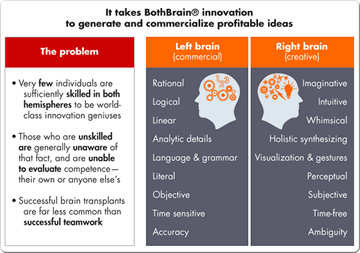記事
That is one of the key reasons that companies struggle to generate a continuous stream of innovations. They somehow stifle the creativity that leads to game-changing ideas. In turbulent times, they often cut back on innovation efforts rather than increasing them—arguably a recipe for disaster.
Compare that all-too-common situation with companies that have truly changed the game in their industries. What you find there are distinctive kinds of partnerships, often permeating the organizations. One partner is an imaginative, intuitive "right-brain" individual who spins out new ideas every day and seems somehow to channel the wants and needs of target customers. The other partner is invariably a "left brain" executive, someone comfortable making commercial decisions based on hard-nosed analysis. This left-brain, right-brain language is just shorthand—the capabilities associated with each don't reside purely in the corresponding region of the cerebral cortex. But it's a useful taxonomy, which is why we call these companies "BothBrain®" organizations.
View a larger version of this chart
BothBrain partnerships turn up in all sorts of industries. Howard Schultz conceived and developed the iconic Starbucks coffeehouse format, while CEO Orin Smith oversaw the chain's rapid growth. Former track coach Bill Bowerman developed Nike's innovative running shoes, while partner Phil Knight handled management, finance and sales. Steve Jobs famously acts as Apple's creative director, overseeing nearly every aspect of innovations such as the iPhone, while COO Tim Cook handles the day-to-day running of the business.
Some highly innovative industries put BothBrain partnerships at the center of their business model. Virtually every successful brand in the fashion industry, for instance, is run by a partnership between a creative director and a brand CEO. Fashion companies foster collaboration of this sort throughout the organization, not just at the top. They carefully spell out who has responsibility for decisions relating to innovation. Creative directors, for example, have final say over new-product decisions, but must work within commercial frameworks laid down by brand managers.
Like fashion companies, innovative organizations in other industries have begun to build BothBrain partnerships deliberately. Procter & Gamble, for instance—traditionally known for its analytic approach to brand management—has made itself into an innovation leader partly by emphasizing creative, design-oriented, right-brain thinking.
Darrell Rigby is a partner at Bain & Company and leads the firm's Global Retail and Innovation practices. Kara Gruver, a partner in the Bain Boston office, leads the firm's regional practice areas for Retail and Consumer Products. James Allen, a partner in London, is co-leader of the firm's Global Strategy practice.
Additional articles appearing in this edition of the Results Brief newsletter:
Private equity's new landscape
by Hugh MacArthur, Graham Elton, Bill Halloran and Chul-Joon Park
The worst for private equity may be over. But as the market improves, the more pressing question is where does the industry go from here? For small-cap and growth funds, the past year may turn out to have been a speed bump. Deal volume is down, but given the lower debt requirements and manageable sizes, these deals will be the first to come back. Among mid- and large-cap firms, this period of crisis is likely to provoke a significant reshuffling of the deck. Rising to the top will depend on how quickly and sustainably you can develop three sets of capabilities.
Downturns create an opportunity to strengthen IT
by Donie Lochan and Sachin Shah
Managing information technology in a downturn is different from normal IT management and cost discipline. When economic turbulence strikes, IT needs quickly to realign with new business priorities. CIOs will be charged with keeping IT investments under control, radically cutting costs, while at the same time doing some clever prioritizing to address new business needs-the discipline to "do even more with less" becomes the mantra of today's CIO. The trouble is that many companies instinctively look at their information technology departments primarily as an easy place to cut costs. It's an impulse that will prove expensive down the road.

Winning in Turbulence
Learn more about how companies can navigate through turbulent times and succeed as the economy improves.
